
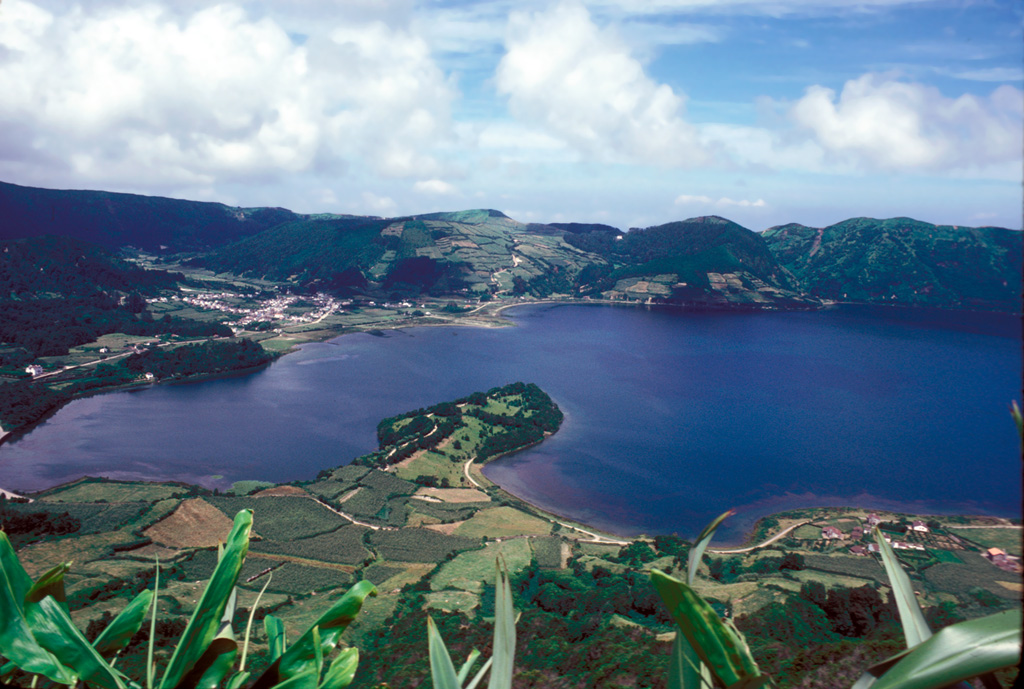
Seismic swarm on submarine flank
Since June 1998, increasing seismic activity in the vicinity of Sete Cidades volcano has resulted in occasional seismic swarms. On the night of 2-3 August about 120 events were registered in 3 hours. During that period, five earthquakes were felt along the W coast, the strongest with a magnitude of 3.1 reached a maximum intensity of V (MM) at Ginetes e Varzea. Similarly, on 2 September in Sao Miguel more than 120 events occurred beneath the sea floor over a period of about 4 hours near shore between Ponta da Ferraria and Mosteiros. One of the five felt earthquakes during this period also reached an intensity of V (MM). There were no reports of injury or damage from any of these events.
Information Contacts: João Luis Gaspar and Nicolau Wallenstein, Departamento de Geociencias, Centro de Vulcanologia, Universidade dos Açores, Rua Mae de Deus, 9500 - Ponta Delgada, Sao Miguel, Açores, Portugal.
The Global Volcanism Program has no Weekly Reports available for Sete Cidades.
Reports are organized chronologically and indexed below by Month/Year (Publication Volume:Number), and include a one-line summary. Click on the index link or scroll down to read the reports.
Seismic swarm on submarine flank
Since June 1998, increasing seismic activity in the vicinity of Sete Cidades volcano has resulted in occasional seismic swarms. On the night of 2-3 August about 120 events were registered in 3 hours. During that period, five earthquakes were felt along the W coast, the strongest with a magnitude of 3.1 reached a maximum intensity of V (MM) at Ginetes e Varzea. Similarly, on 2 September in Sao Miguel more than 120 events occurred beneath the sea floor over a period of about 4 hours near shore between Ponta da Ferraria and Mosteiros. One of the five felt earthquakes during this period also reached an intensity of V (MM). There were no reports of injury or damage from any of these events.
Information Contacts: João Luis Gaspar and Nicolau Wallenstein, Departamento de Geociencias, Centro de Vulcanologia, Universidade dos Açores, Rua Mae de Deus, 9500 - Ponta Delgada, Sao Miguel, Açores, Portugal.
|
|
||||||||||||||||||||||||||
There is data available for 16 confirmed eruptive periods.
1880 Confirmed Eruption (Explosive / Effusive) VEI: 0
| Episode 1 | Eruption (Explosive / Effusive) | Volcano Uncertain: submarine vent off Sao Miguel | |||||||||||||
|---|---|---|---|---|---|---|---|---|---|---|---|---|---|---|
| 1880 - Unknown | Evidence from Unknown | |||||||||||||
|
List of 1 Events for Episode 1 at Volcano Uncertain: submarine vent off Sao Miguel
|
||||||||||||||
1861 Confirmed Eruption (Explosive / Effusive) VEI: 0
| Episode 1 | Eruption (Explosive / Effusive) | Volcano Uncertain: submarine vent off Sao Miguel | |||||||||||||
|---|---|---|---|---|---|---|---|---|---|---|---|---|---|---|
| 1861 - Unknown | Evidence from Unknown | |||||||||||||
|
List of 1 Events for Episode 1 at Volcano Uncertain: submarine vent off Sao Miguel
|
||||||||||||||
1811 Jun 14 - 1811 Jun 22 Confirmed Eruption (Explosive / Effusive) VEI: 3
| Episode 1 | Eruption (Explosive / Effusive) | Submarine vent west of Sete Cidades | |||||||||||||||||||||||
|---|---|---|---|---|---|---|---|---|---|---|---|---|---|---|---|---|---|---|---|---|---|---|---|---|
| 1811 Jun 14 - 1811 Jun 22 | Evidence from Observations: Reported | |||||||||||||||||||||||
|
List of 3 Events for Episode 1 at Submarine vent west of Sete Cidades
|
||||||||||||||||||||||||
1811 Feb 1 - 1811 Feb 8 Confirmed Eruption (Explosive / Effusive) VEI: 2 (?)
| Episode 1 | Eruption (Explosive / Effusive) | Submarine vent west of Sete Cidades | |||||||||||||||||||||||
|---|---|---|---|---|---|---|---|---|---|---|---|---|---|---|---|---|---|---|---|---|---|---|---|---|
| 1811 Feb 1 - 1811 Feb 8 | Evidence from Observations: Reported | |||||||||||||||||||||||
|
List of 3 Events for Episode 1 at Submarine vent west of Sete Cidades
|
||||||||||||||||||||||||
1713 Confirmed Eruption (Explosive / Effusive) VEI: 2
| Episode 1 | Eruption (Explosive / Effusive) | West flank (Pico das Camarinhas) | |||||||||||||||||||||||||||||||||
|---|---|---|---|---|---|---|---|---|---|---|---|---|---|---|---|---|---|---|---|---|---|---|---|---|---|---|---|---|---|---|---|---|---|---|
| 1713 - Unknown | Evidence from Observations: Reported | |||||||||||||||||||||||||||||||||
|
List of 5 Events for Episode 1 at West flank (Pico das Camarinhas)
|
||||||||||||||||||||||||||||||||||
1682 Dec 13 Confirmed Eruption (Explosive / Effusive) VEI: 2
| Episode 1 | Eruption (Explosive / Effusive) | Submarine vent west of Sete Cidades | ||||||||||||||||||||||||||||
|---|---|---|---|---|---|---|---|---|---|---|---|---|---|---|---|---|---|---|---|---|---|---|---|---|---|---|---|---|---|
| 1682 Dec 13 - Unknown | Evidence from Observations: Reported | ||||||||||||||||||||||||||||
|
List of 4 Events for Episode 1 at Submarine vent west of Sete Cidades
|
|||||||||||||||||||||||||||||
1638 Jul 3 - 1638 Jul 28 Confirmed Eruption (Explosive / Effusive) VEI: 2
| Episode 1 | Eruption (Explosive / Effusive) | Submarine vent west of Sete Cidades | ||||||||||||||||||||||||||||
|---|---|---|---|---|---|---|---|---|---|---|---|---|---|---|---|---|---|---|---|---|---|---|---|---|---|---|---|---|---|
| 1638 Jul 3 - 1638 Jul 28 | Evidence from Observations: Reported | ||||||||||||||||||||||||||||
|
List of 4 Events for Episode 1 at Submarine vent west of Sete Cidades
|
|||||||||||||||||||||||||||||
1444 (?) Confirmed Eruption (Explosive / Effusive) VEI: 4
| Episode 1 | Eruption (Explosive / Effusive) | SW side of caldera (Caldeira Seca) | ||||||||||||||||||||||||||||||||||||||
|---|---|---|---|---|---|---|---|---|---|---|---|---|---|---|---|---|---|---|---|---|---|---|---|---|---|---|---|---|---|---|---|---|---|---|---|---|---|---|---|
| 1444 (?) - Unknown | Evidence from Observations: Reported | ||||||||||||||||||||||||||||||||||||||
|
List of 6 Events for Episode 1 at SW side of caldera (Caldeira Seca)
|
|||||||||||||||||||||||||||||||||||||||
1110 ± 50 years Confirmed Eruption (Explosive / Effusive) VEI: 2
| Episode 1 | Eruption (Explosive / Effusive) | West flank (Ponta de Ferraria) | ||||||||||||||||||||||||||||
|---|---|---|---|---|---|---|---|---|---|---|---|---|---|---|---|---|---|---|---|---|---|---|---|---|---|---|---|---|---|
| 1110 ± 50 years - Unknown | Evidence from Isotopic: 14C (uncalibrated) | ||||||||||||||||||||||||||||
|
List of 4 Events for Episode 1 at West flank (Ponta de Ferraria)
|
|||||||||||||||||||||||||||||
0950 ± 100 years Confirmed Eruption (Explosive / Effusive) VEI: 2
| Episode 1 | Eruption (Explosive / Effusive) | SE flank (Ferraria) | |||||||||||||||||||||||||||||||||
|---|---|---|---|---|---|---|---|---|---|---|---|---|---|---|---|---|---|---|---|---|---|---|---|---|---|---|---|---|---|---|---|---|---|---|
| 0950 ± 100 years - Unknown | Evidence from Isotopic: 14C (uncalibrated) | |||||||||||||||||||||||||||||||||
|
List of 5 Events for Episode 1 at SE flank (Ferraria)
|
||||||||||||||||||||||||||||||||||
0670 ± 150 years Confirmed Eruption (Explosive / Effusive) VEI: 3
| Episode 1 | Eruption (Explosive / Effusive) | SE flank (Carvao) | |||||||||||||||||||||||||||||||||
|---|---|---|---|---|---|---|---|---|---|---|---|---|---|---|---|---|---|---|---|---|---|---|---|---|---|---|---|---|---|---|---|---|---|---|
| 0670 ± 150 years - Unknown | Evidence from Isotopic: 14C (uncalibrated) | |||||||||||||||||||||||||||||||||
|
List of 5 Events for Episode 1 at SE flank (Carvao)
|
||||||||||||||||||||||||||||||||||
0380 ± 300 years Confirmed Eruption (Explosive / Effusive) VEI: 4
| Episode 1 | Eruption (Explosive / Effusive) | SE caldera floor (Lagoa Rasa) | |||||||||||||||||||||||||||||||||
|---|---|---|---|---|---|---|---|---|---|---|---|---|---|---|---|---|---|---|---|---|---|---|---|---|---|---|---|---|---|---|---|---|---|---|
| 0380 ± 300 years - Unknown | Evidence from Correlation: Tephrochronology | |||||||||||||||||||||||||||||||||
|
List of 5 Events for Episode 1 at SE caldera floor (Lagoa Rasa)
|
||||||||||||||||||||||||||||||||||
0090 ± 100 years Confirmed Eruption (Explosive / Effusive) VEI: 4
| Episode 1 | Eruption (Explosive / Effusive) | SE caldera floor (Lagoa de Santiago) | ||||||||||||||||||||||||||||
|---|---|---|---|---|---|---|---|---|---|---|---|---|---|---|---|---|---|---|---|---|---|---|---|---|---|---|---|---|---|
| 0090 ± 100 years - Unknown | Evidence from Isotopic: 14C (uncalibrated) | ||||||||||||||||||||||||||||
|
List of 4 Events for Episode 1 at SE caldera floor (Lagoa de Santiago)
|
|||||||||||||||||||||||||||||
0750 BCE ± 300 years Confirmed Eruption (Explosive / Effusive)
| Episode 1 | Eruption (Explosive / Effusive) | SE flank (Eguas) | ||||||||||||||||||||||||||||
|---|---|---|---|---|---|---|---|---|---|---|---|---|---|---|---|---|---|---|---|---|---|---|---|---|---|---|---|---|---|
| 0750 BCE ± 300 years - Unknown | Evidence from Isotopic: 14C (uncalibrated) | ||||||||||||||||||||||||||||
|
List of 4 Events for Episode 1 at SE flank (Eguas)
|
|||||||||||||||||||||||||||||
2050 BCE ± 1000 years Confirmed Eruption (Explosive / Effusive)
| Episode 1 | Eruption (Explosive / Effusive) | Caldeira do Alfreres and NW flank | |||||||||||||||||||||||
|---|---|---|---|---|---|---|---|---|---|---|---|---|---|---|---|---|---|---|---|---|---|---|---|---|
| 2050 BCE ± 1000 years - Unknown | Evidence from Correlation: Tephrochronology | |||||||||||||||||||||||
|
List of 3 Events for Episode 1 at Caldeira do Alfreres and NW flank
|
||||||||||||||||||||||||
3050 BCE (?) Confirmed Eruption (Explosive / Effusive) VEI: 4
| Episode 1 | Eruption (Explosive / Effusive) | Seara Cerrado da Ladeira | |||||||||||||||||||||||
|---|---|---|---|---|---|---|---|---|---|---|---|---|---|---|---|---|---|---|---|---|---|---|---|---|
| 3050 BCE (?) - Unknown | Evidence from Correlation: Tephrochronology | |||||||||||||||||||||||
|
List of 3 Events for Episode 1 at Seara Cerrado da Ladeira
|
||||||||||||||||||||||||
This compilation of synonyms and subsidiary features may not be comprehensive. Features are organized into four major categories: Cones, Craters, Domes, and Thermal Features. Synonyms of features appear indented below the primary name. In some cases additional feature type, elevation, or location details are provided.
Cones |
||||
| Feature Name | Feature Type | Elevation | Latitude | Longitude |
| Boi, Pico do | Cone | 542 m | 37° 49' 0.00" N | 25° 43' 0.00" W |
| Camarinhas, Pico das | Cone | 219 m | 37° 51' 0.00" N | 25° 51' 0.00" W |
| Carvao | Cone | 815 m | 37° 49' 0.00" N | 25° 44' 0.00" W |
| Cavalo, Pico do | Cone | 215 m | 37° 51' 0.00" N | 25° 51' 0.00" W |
| Cedro, Pico do | Cone | 387 m | 37° 49' 0.00" N | 25° 42' 0.00" W |
| Cruz, Pico da | Cone | 842 m | 37° 50' 45.00" N | 25° 45' 27.00" W |
| Eguas | Cone | 844 m | 37° 49' 36.00" N | 25° 45' 16.00" W |
| Enforcado, Pico do | Cone | 338 m | 37° 48' 0.00" N | 25° 41' 0.00" W |
| Ferrarias | Cone | 37° 50' 0.00" N | 25° 46' 0.00" W | |
| Ilheu Dos Mosteiros | Cone | 37° 55' 0.00" N | 25° 50' 0.00" W | |
| Mafra, Pico de | Cone | 360 m | ||
| Mulata | Cone | 373 m | 37° 48' 0.00" N | 25° 42' 0.00" W |
| Pilar, Lagoa do | Cone | 332 m | 37° 54' 0.00" N | 25° 47' 0.00" W |
| Seara | Tuff cone | 460 m | 37° 52' 29.00" N | 25° 48' 25.00" W |
| Seara Cerrado de Ladeira | Pyroclastic cone | 475 m | 37° 52' 34.00" N | 25° 47' 43.00" W |
| Varzea, Pico do | Cone | 275 m | 37° 52' 0.00" N | 25° 50' 0.00" W |
Craters |
||||
| Feature Name | Feature Type | Elevation | Latitude | Longitude |
| Alferes, Caldeira do | Pumice ring | 386 m | 37° 52' 6.00" N | 25° 48' 14.00" W |
| Canario, Lagoa do | Maar | 811 m | 37° 50' 0.00" N | 25° 46' 0.00" W |
| Rasa, Lagoa | Pumice ring | 565 m | 37° 50' 35.00" N | 25° 46' 45.00" W |
| Santiago, Lagoa de
Sao Tiago, Lagoa de |
Pumice ring | 372 m | 37° 50' 51.00" N | 25° 46' 26.00" W |
| Seca, Caldeira | Pumice ring | 313 m | 37° 51' 20.00" N | 25° 48' 10.00" W |
| Sete Cidades | Caldera | 260 m | 37° 51' 26.00" N | 25° 47' 11.00" W |
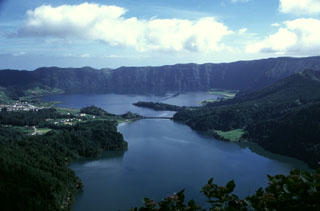 The 5-km-wide Sete Cidades caldera, seen from the southern rim, with lakes Lagoa Verde (foreground) and Lagoa Azul (background) that occupy much of the central caldera floor. To the east (right) and west (left) of these lakes are several pyroclastic cones that have formed in explosive eruptions during the last 5,000 years.
The 5-km-wide Sete Cidades caldera, seen from the southern rim, with lakes Lagoa Verde (foreground) and Lagoa Azul (background) that occupy much of the central caldera floor. To the east (right) and west (left) of these lakes are several pyroclastic cones that have formed in explosive eruptions during the last 5,000 years.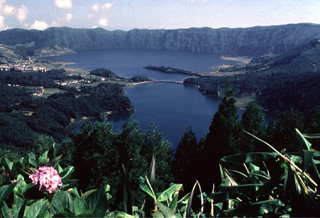 The summit caldera of Sete Cidades volcano at the western end of Sao Miguel Island contains two lakes and is one of the scenic highlights of the Azores. A nearly circular ring of six Holocene pyroclastic cones occupies the floor of the 5-km-wide caldera and has been the source of a dozen major explosive eruptions during the past 5000 years. Sete Cidades is one of the most active Azorean volcanoes. Historical eruptions date back to the 15th century and have occurred from within the caldera and from submarine vents off the west coast.
The summit caldera of Sete Cidades volcano at the western end of Sao Miguel Island contains two lakes and is one of the scenic highlights of the Azores. A nearly circular ring of six Holocene pyroclastic cones occupies the floor of the 5-km-wide caldera and has been the source of a dozen major explosive eruptions during the past 5000 years. Sete Cidades is one of the most active Azorean volcanoes. Historical eruptions date back to the 15th century and have occurred from within the caldera and from submarine vents off the west coast. 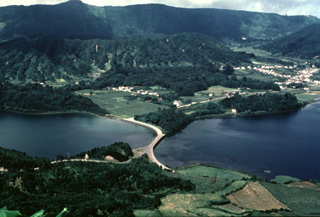 A highway bridge spans the junction of Lagoa Verde (left) and Lagoa Azul (right) lakes on the floor of Sete Cidades caldera. The erosionally furrowed wall of Caldeira Seca, the youngest of a circular group of post-caldera pyroclastic cones constructed within 5-km-wide Sete Cidades caldera, rises beyond the two lakes. The town of Sete Cidades (upper right) occupies the caldera floor between Caldeira Seca and another youthful pumice cone, Caldeira do Alferes.
A highway bridge spans the junction of Lagoa Verde (left) and Lagoa Azul (right) lakes on the floor of Sete Cidades caldera. The erosionally furrowed wall of Caldeira Seca, the youngest of a circular group of post-caldera pyroclastic cones constructed within 5-km-wide Sete Cidades caldera, rises beyond the two lakes. The town of Sete Cidades (upper right) occupies the caldera floor between Caldeira Seca and another youthful pumice cone, Caldeira do Alferes.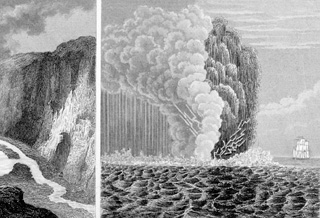 This 19th-century sketch shows a submarine eruption during 1811 off the western coast of Sao Miguel Island in the Azores. Lightning flashes appear at the base of the eruption column, which consists of both a light-colored steam cloud and a darker, ash-laden eruption plume. Explosive eruptions took place February 1-8 and June 16-22, 1811 from the submarine vent. The June eruptions formed an ephemeral island named Sabrina that at its peak stage of growth was 2-km long and 90-m high.
This 19th-century sketch shows a submarine eruption during 1811 off the western coast of Sao Miguel Island in the Azores. Lightning flashes appear at the base of the eruption column, which consists of both a light-colored steam cloud and a darker, ash-laden eruption plume. Explosive eruptions took place February 1-8 and June 16-22, 1811 from the submarine vent. The June eruptions formed an ephemeral island named Sabrina that at its peak stage of growth was 2-km long and 90-m high.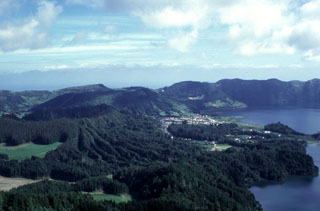 The western section of the Sete Cidades caldera is seen in this view from the southern caldera rim. Lagoa Verde (bottom right) and Lagoa Azul (center right) stretch across the center of the caldera, bounded to the east and west by pyroclastic cones. Here, three forested cones can be seen that formed during the past 5,000 years. These are the Caldeira Seca (left), Caldeira do Alferes (left center), and Seara (behind and to the right of Alferes). The broadly circular caldera forms the horizon in the background.
The western section of the Sete Cidades caldera is seen in this view from the southern caldera rim. Lagoa Verde (bottom right) and Lagoa Azul (center right) stretch across the center of the caldera, bounded to the east and west by pyroclastic cones. Here, three forested cones can be seen that formed during the past 5,000 years. These are the Caldeira Seca (left), Caldeira do Alferes (left center), and Seara (behind and to the right of Alferes). The broadly circular caldera forms the horizon in the background.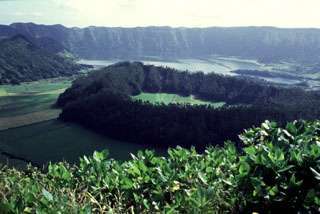 The tree lined, approximately 500 x 700 m, Caldeira Seca pumice ring (center) on the floor of the Sete Cidades caldera, with Lagoa Azul and the northeast wall of the caldera in the background. The southeastern flank of the Calderia do Alferes is seen in the upper left. Caldeira Seca formed during a 15th-century phreatomagmatic eruption in which large amounts of pumice ash, lapilli and blocks were erupted.
The tree lined, approximately 500 x 700 m, Caldeira Seca pumice ring (center) on the floor of the Sete Cidades caldera, with Lagoa Azul and the northeast wall of the caldera in the background. The southeastern flank of the Calderia do Alferes is seen in the upper left. Caldeira Seca formed during a 15th-century phreatomagmatic eruption in which large amounts of pumice ash, lapilli and blocks were erupted.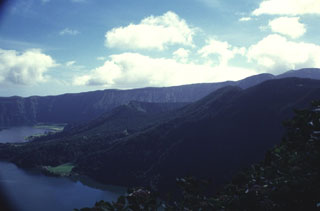 The SE floor of Sete Cidades caldera contains a large trachytic lava dome with two craters containing Lagoa de Santiago and Lagoa Rasa. The rim of Lagoa de Santiago crater is visible in the center. The visible lakes in this image are the Lagoa Verde (left foreground) and Lagoa Azul (left background), that occupy much of the caldera floor. Both explosive eruptions forming Santiago and Rasa occurred within the last 5,000 years.
The SE floor of Sete Cidades caldera contains a large trachytic lava dome with two craters containing Lagoa de Santiago and Lagoa Rasa. The rim of Lagoa de Santiago crater is visible in the center. The visible lakes in this image are the Lagoa Verde (left foreground) and Lagoa Azul (left background), that occupy much of the caldera floor. Both explosive eruptions forming Santiago and Rasa occurred within the last 5,000 years.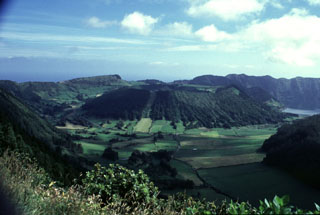 Caldeira do Alferes (center) is one of a group of pyroclastic cones constructed on the floor of Sete Cidades caldera. The adjacent cone of Seara is just visible in the background, right of Caldeira do Alferes in this view from the western caldera rim. The forested slope seen in the right foreground is Caldeira Seca. Explosive trachytic eruptions occurred at least 17 times in the past 5,000 years within the caldera.
Caldeira do Alferes (center) is one of a group of pyroclastic cones constructed on the floor of Sete Cidades caldera. The adjacent cone of Seara is just visible in the background, right of Caldeira do Alferes in this view from the western caldera rim. The forested slope seen in the right foreground is Caldeira Seca. Explosive trachytic eruptions occurred at least 17 times in the past 5,000 years within the caldera.  A small peninsula extends into Lagoa Azul ("Blue Lake"), one of two main lakes partially filling the floor of the summit caldera on Sete Cidades volcano at the western end of Sao Miguel Island. The 5-km-wide caldera was formed in three major eruptions at about 36,000, 29,000 and 16,000 years ago, and at least 17 eruptions have occurred here in the last 5,000 years. This view looks to the northwest from the rim of a post-caldera cone containing Lagoa Santiago. Two other post-caldera cones, Caldeira do Alferes and Seara, lie across the lake, behind and to the right of the town of Sete Cidades.
A small peninsula extends into Lagoa Azul ("Blue Lake"), one of two main lakes partially filling the floor of the summit caldera on Sete Cidades volcano at the western end of Sao Miguel Island. The 5-km-wide caldera was formed in three major eruptions at about 36,000, 29,000 and 16,000 years ago, and at least 17 eruptions have occurred here in the last 5,000 years. This view looks to the northwest from the rim of a post-caldera cone containing Lagoa Santiago. Two other post-caldera cones, Caldeira do Alferes and Seara, lie across the lake, behind and to the right of the town of Sete Cidades.There are no samples for Sete Cidades in the Smithsonian's NMNH Department of Mineral Sciences Rock and Ore collection.
| Copernicus Browser | The Copernicus Browser replaced the Sentinel Hub Playground browser in 2023, to provide access to Earth observation archives from the Copernicus Data Space Ecosystem, the main distribution platform for data from the EU Copernicus missions. |
| MIROVA | Middle InfraRed Observation of Volcanic Activity (MIROVA) is a near real time volcanic hot-spot detection system based on the analysis of MODIS (Moderate Resolution Imaging Spectroradiometer) data. In particular, MIROVA uses the Middle InfraRed Radiation (MIR), measured over target volcanoes, in order to detect, locate and measure the heat radiation sourced from volcanic activity. |
| MODVOLC Thermal Alerts | Using infrared satellite Moderate Resolution Imaging Spectroradiometer (MODIS) data, scientists at the Hawai'i Institute of Geophysics and Planetology, University of Hawai'i, developed an automated system called MODVOLC to map thermal hot-spots in near real time. For each MODIS image, the algorithm automatically scans each 1 km pixel within it to check for high-temperature hot-spots. When one is found the date, time, location, and intensity are recorded. MODIS looks at every square km of the Earth every 48 hours, once during the day and once during the night, and the presence of two MODIS sensors in space allows at least four hot-spot observations every two days. Each day updated global maps are compiled to display the locations of all hot spots detected in the previous 24 hours. There is a drop-down list with volcano names which allow users to 'zoom-in' and examine the distribution of hot-spots at a variety of spatial scales. |
|
WOVOdat
Single Volcano View Temporal Evolution of Unrest Side by Side Volcanoes |
WOVOdat is a database of volcanic unrest; instrumentally and visually recorded changes in seismicity, ground deformation, gas emission, and other parameters from their normal baselines. It is sponsored by the World Organization of Volcano Observatories (WOVO) and presently hosted at the Earth Observatory of Singapore.
GVMID Data on Volcano Monitoring Infrastructure The Global Volcano Monitoring Infrastructure Database GVMID, is aimed at documenting and improving capabilities of volcano monitoring from the ground and space. GVMID should provide a snapshot and baseline view of the techniques and instrumentation that are in place at various volcanoes, which can be use by volcano observatories as reference to setup new monitoring system or improving networks at a specific volcano. These data will allow identification of what monitoring gaps exist, which can be then targeted by remote sensing infrastructure and future instrument deployments. |
| Volcanic Hazard Maps | The IAVCEI Commission on Volcanic Hazards and Risk has a Volcanic Hazard Maps database designed to serve as a resource for hazard mappers (or other interested parties) to explore how common issues in hazard map development have been addressed at different volcanoes, in different countries, for different hazards, and for different intended audiences. In addition to the comprehensive, searchable Volcanic Hazard Maps Database, this website contains information about diversity of volcanic hazard maps, illustrated using examples from the database. This site is for educational purposes related to volcanic hazard maps. Hazard maps found on this website should not be used for emergency purposes. For the most recent, official hazard map for a particular volcano, please seek out the proper institutional authorities on the matter. |
| IRIS seismic stations/networks | Incorporated Research Institutions for Seismology (IRIS) Data Services map showing the location of seismic stations from all available networks (permanent or temporary) within a radius of 0.18° (about 20 km at mid-latitudes) from the given location of Sete Cidades. Users can customize a variety of filters and options in the left panel. Note that if there are no stations are known the map will default to show the entire world with a "No data matched request" error notice. |
| UNAVCO GPS/GNSS stations | Geodetic Data Services map from UNAVCO showing the location of GPS/GNSS stations from all available networks (permanent or temporary) within a radius of 20 km from the given location of Sete Cidades. Users can customize the data search based on station or network names, location, and time window. Requires Adobe Flash Player. |
| DECADE Data | The DECADE portal, still in the developmental stage, serves as an example of the proposed interoperability between The Smithsonian Institution's Global Volcanism Program, the Mapping Gas Emissions (MaGa) Database, and the EarthChem Geochemical Portal. The Deep Earth Carbon Degassing (DECADE) initiative seeks to use new and established technologies to determine accurate global fluxes of volcanic CO2 to the atmosphere, but installing CO2 monitoring networks on 20 of the world's 150 most actively degassing volcanoes. The group uses related laboratory-based studies (direct gas sampling and analysis, melt inclusions) to provide new data for direct degassing of deep earth carbon to the atmosphere. |
| Large Eruptions of Sete Cidades | Information about large Quaternary eruptions (VEI >= 4) is cataloged in the Large Magnitude Explosive Volcanic Eruptions (LaMEVE) database of the Volcano Global Risk Identification and Analysis Project (VOGRIPA). |
| EarthChem | EarthChem develops and maintains databases, software, and services that support the preservation, discovery, access and analysis of geochemical data, and facilitate their integration with the broad array of other available earth science parameters. EarthChem is operated by a joint team of disciplinary scientists, data scientists, data managers and information technology developers who are part of the NSF-funded data facility Integrated Earth Data Applications (IEDA). IEDA is a collaborative effort of EarthChem and the Marine Geoscience Data System (MGDS). |